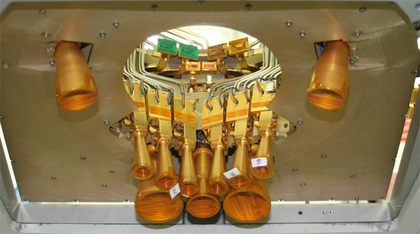Low Frequency Instrument (LFI)

The Low Frequency Instrument (LFI) on Planck uses state of the art microwave radiometers to map the sky in three frequency bands from 30 to 70 GHz. A radiometer measures radiation (microwave light) and produces a signal proportional to the temperature of the object being viewed. In a way, Planck is taking the temperature of the universe.
The LFI uses highly sensitive microwave amplifiers. The devices in these amplifiers were designed and tested in a collaboration between the Jet Propulsion Laboratory and Northrup Grumman Space Technology. To measure the very faint signals from the cosmic microwave background (CMB), these amplifiers must be cryogenically cooled to 20 Kelvin (-253 C).
In order to achieve the extraordinary stability required by Planck, the LFI radiometers have a rather complex design called a pseudo-correlation continuous comparison receiver (Bersanelli 1995). This complicated structure effectively compares the temperature of the CMB to that of a thermally stable "reference load". This allows us to remove tiny changes in the gain of the cryogenic amplifiers and see the underlying signal from the sky.
